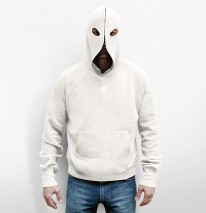Years ago, in writing about privacy in public places and the rise of ubiquitous camera surveillance — a state now nearly achieved in parts of the UK and the US, and coming to a lamppost near you — I predicted that masks would become a hot fashion accessory. And sure enough, in the UK someone is selling Hoodie sweatshirts with integrated masks. (spotted via Boing Boing)

I don’t know what the law is in the UK, but in the US we have mask laws in many states (written originally to stamp out the KKK), that prohibit the wearing of masks in public. These laws are enforced somewhat erratically — they never seem to apply on Oct. 31. And some courts have ruled them unconstitutional, although others have upheld them.
There have been a few cases since I wrote The Death of Privacy?, which is a general survey of technological threats to privacy and possible responses, but if you would like a brief discussion of the legal issues relating to masks you will find them in Section II.B.1.b.

Do anybody but lawyers write stuff with a “Section II.B.1.b.”? Does any document really require that much structure for reference? Name any really important work with four levels of overt structure. SCOTUS opinions don’t have any, do they?
The other technical problem with this Aristotelian scheme is that it doesn’t cope well with levels of importance, digressions, and technical stuff for experts only. The computer-programming convention of nested indents handles this well, but is hard to combine with any other structural system of reference beyond line numbers. You can also use typographical cues like different font sizes.
Ideas are linked, and don’t stay quietly in their boxes like dead beetles in a natural history museum.
Sure, lots of people write with structure. Read a technical manual recently?
Plus, lots of people who don’t write with structure might benefit from it. I’m not writing a novel, I’m trying to tell you about something complicated in as clear a manner as I know how.
As for the alleged war between structure and the valuable but untidy digression, may I introduce you to the dreaded two-page legal footnote?
There’s surely a place for stream of consciousness, but I think part of the value-added of at least my brand of legal academic work is the imposition of structure on complex and seemingly chaotic or untidy landscapes of ideas. (Plus, it makes it easier to find and refer to one part of the whole when one needs to.)
There are now signs up in and around the white house in DC that note that the area is under camera surveillance (oddly, they seem to be put there by the DC police force, not the feds, as I would have thought the Secret Service would do this and monitor it, maybe its both).
I am half tempted to put on a mask and walk from 15th and Penn to 17th and Penn (the stretch closed to traffic permanently) and see what happens. Though I might need to check the DC code to see if they have a “no mask in public” law. I’m also tempted to go around and photograph all these things and put them up on a website. Sadly, I doubt I’ll ever do either.
I dissent from the prediction. Overall, people don’t notice cameras.
What happens with a flu pandemic? Anyone remember the pictures from China during the SARS scare? Everyone was wearing a surgical mask.
What about the use of makeup? Tatoos, wigs, hats, glasses or whatever? Other feature disguising materials?? Seems like one could do some Googleing of the use of masking techniques used in wartime (lighting, dazzlepaint etc).
Interesting.
Burqas for everyone!
You mean “Freedumb Burqas”…